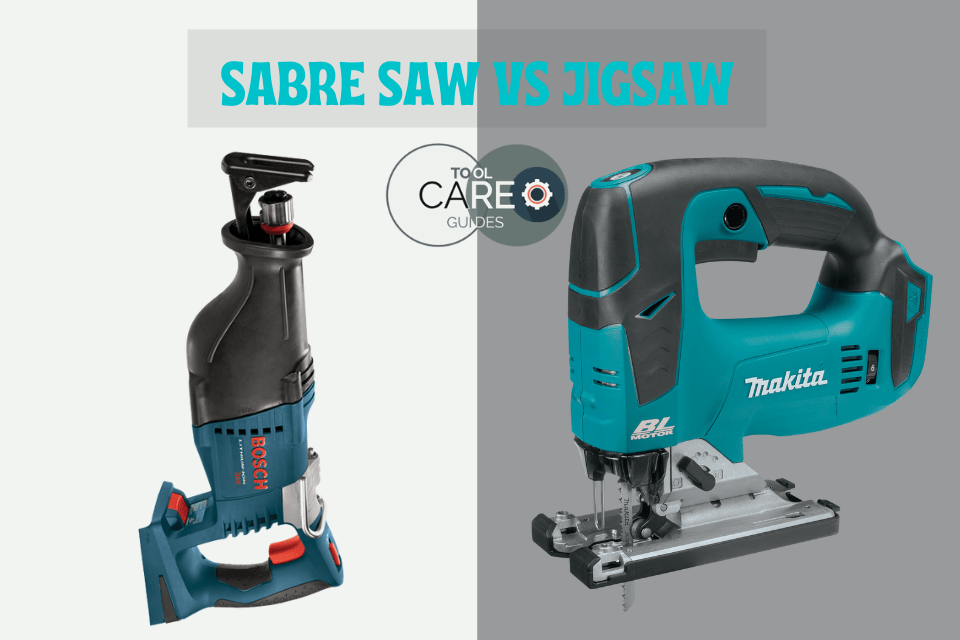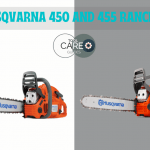Quick Overview of This Article
A jigsaw and a Sabre Saw are portable and handheld electric tools that come with thin blades for cutting scrolls and odd, non-linear shapes.
The difference between jigsaw and Sabre Saw is that the jigsaw is smaller than a Sabre Saw.
A Jigsaw has a sole plate while the Sabre Saw doesn’t. And the jigsaw is more accurate than a Sabre Saw, which is known for its power capabilities.
Inarguably, these two saws are the most confusing in woodcutting tools. Even the most experienced woodworkers find themselves using the two terms interchangeably.
If you are not keen on the differences, you can mess up big times when purchasing jigsaw or sabre saw. You may end up with the wrong saw for the job, especially if you are looking for a special application saw.
But no worries as you got our back. Our article will dwell more on these two saws that belong to the same family. You will find that the two are different and are used in various applications.
We will tell you when to use the saws and how to pick the best saw for your situation, not forgetting the pros and cons of each one of them.
Go through our Sabre Saw VS Jigsaw article to avoid mixing up these two power saws.
What Is A Jigsaw?
Let’s swirl you to a history class to clasp more about this power too. The jigsaw dates back to 1946, when Albert Kaufmann, a Swiss engineer, upgraded his wife’s sewing machine by replacing the needle with a thin blade.
Of course, the first jigsaw wasn’t as effective as today’s tool, but within the decades, the tool has toned to the modern tool that is one of the most sought-after carpentry and woodwork.
If you have an intricate cutting task ahead that requires rounded curves and precision, you will entrust the job to a jigsaw. The saw has a variety of applications that includes detailed jobs.
A jigsaw combines a reciprocating blade and an electric motor. The reciprocating blade gives the saw its other name, the reciprocating saw.
The jigsaw’s blade is popular for its versatility. Although its thin blade breaks quite quickly, the saw’s application is wide both at home for DIY projects and at sites for professional use.
Jigsaws have two types of blade fitments. Some older models use a screw to clench the blade in place. The newer types lock the edge in position using a slot.
Another outstanding feature that you should never forget with the jigsaw is that the blades have a range of teeth counts between 7 to 25. The teeth can even more, depending on the jigsaw application.
Jigsaws come cordless or corded depending on the power source; cordless for the battery-powered form and corded for electric power. Using this tool is relatively easy, from learning to application.
You will find jigsaws compact, thus easy to work within tight spaces and keep in limited storage spaces. With jigsaws, you will fix the blade, cut through different materials and trust the tool for precise tasks at hand.
Features of Jigsaw
There are four major features of a jigsaw;
- Motor
The motor is the heartbeat of a jigsaw. The power outlet channels the power energy from the power outlet or a battery to drive the blade to cut.
- Blade
The blade is the cutting aid. A jigsaw blade defers with the application. Some cut wood, plastic, metal, and other materials, but we have the generic ones that cut almost any material. Your choice of the blade depends on the task ahead.
- Stroke length
The stroke length feature is the distance a blade moves upwards and downwards in a stroke. A higher stroke rate means that a blade will cover a greater distance than a lower stroke rate.
- Shoe
A jigsaw shoe is a plate strategically placed to protect the blade. The feature anchors the target against the cutting target. A jigsaw shoe is adjustable, which is makes it easy to cut angled cuts and slippery material.
When to Use a Jigsaw
As we mentioned above, a jigsaw is a precise cutting tool. If you have a project that entails cutting shapes that require higher accuracy, the saw will come in handy. The saw cuts in a non-linear motion, thus less applicable in cutting straight lines.
Due to oscillate cutting ability, you can also use a jigsaw for bevel cuts. Most jigsaws bevel up at a 45° angle in both directions.
In addition, jigsaws have a stand-alone blade, making them easy to cut in precision metal, wood, and plastics. So if you are beginning your curving profession, you will find jigsaw a perfect pick.
Pros and Cons
A jigsaw is a surprise tool that comes with loads of benefits. But the tool also comes with several setbacks. Understanding both the pros and cons of a jigsaw will lead you to purchase the right tool for your situation.
Pros
- Safe to use.
- Great ergonomics.
- Jigsaw is known for accuracy.
- It cuts rounded curves perfectly.
- Versatile.
Cons
- Slow and a time-consuming tool
- Jigsaws have a weak blade that is susceptible to breaking.
- Requires a table to use.
- They are not suitable for demolitions.
- It is expensive than a Sabre Saw.
What Is A Sabre Saw?
A sabre saws (interchangeably spelled ‘saber’) is larger than a jigsaw and uses a toothed blade for cutting. A Sabre Saw does not have a sole plate, as a jigsaw does. That means that Saber saws are a lot more challenging to control than a jigsaw.
Because a Sabre Saw has no plate to guide the saw when cutting, you can only control the saw minimally. The result is misaligned and misguided cuts with less accuracy.
An advantage of a Saber is it doesn’t require a tabletop to work.
Features of Sabre Saw
Like the jigsaw, a Sabre Saw has four features;
- Motor
A Saber is not a manual tool. The tool is battery or electrical power-driven. The battery-driven Sabre Saws are cordless, while the electrical-driven ones are corded.
- Shoe
Not the shoe you have on your fee! It’s a feature to position against the target (the material you’re cutting). This part is crucial as it substitutes tabletop in the jigsaw set.
- Blade
Without a blade, the Sabre Saw is meaningless. The edge is the cutting part and comes in different grades and designs for cutting through various materials.
- Stroke Length
The Sabre Saw’s stroke length refers to the distance the blade travels in a single stroke.
When to Use a Sabre Saw?
A Sabre Saw is not as accurate as you would like, but they are super fast. You can use the saw for demolition with flexibility. Attaching the right blade will enable you to rip any material on your way.
But for more nuanced and detailed projects, a jigsaw will do better.
Pros and Cons
Here are the strengths and weaknesses of Sabre Saws;
Strengths
- Superfast saw that can save you time.
- The saws are cheaper than jigsaws.
- Rips and tears down materials easily and fast.
- The saw does not require a tabletop.
Weaknesses
- Inaccurate.
- Limited use.
- Powerful saw.
Should You Get the Jigsaw or The Sabre Saw?
We promised to help you differentiate between a jigsaws vs Sabre Saws. The reality is, the two tools are not the same. As we have expounded each saw, the two may have almost similar features, but their applications are different.
Both saber saw and jigsaw are helpful in all craftsmanship projects, but how do you decide which is best for you? Straightforward!
The first question you will seek an answer is the tool’s application. What project lies ahead of you? Do you want to demolish a structure? Are you looking to carve or cut curves more than linear shapes?
If you answer those two questions, then you will take home the best saw ever. A Sabre Saw will be great for demolitions, while the cousin tool, jigsaw, will help you attain great curves and accuracy.
What about a tool that can multitask? We bet that’s what you desire. Without bias, a jigsaw can help you accomplish an array of projects. The saw can cut through different materials, including wood, metal, plastic and others.
But you can consider both tools in your workshop. There are times you may want an agile and robust tool to do cheap demolitions; a Sabre Saw will come in handy. A jigsaw will cut several shapes for you but much slower.
The verdict
A jigsaw is more popular than a Sabre Saw, but both can work wonders in various projects. Although many people mistake the Sabre Saw for a jigsaw and vice versa, the two are not the same tools. Each has its design and application.
You will use the Sabre Saw for a few tasks, such as demolishing structures due to its robust blade. On the other hand, the jigsaw is a frail little blade that breaks easily but performs many duties. You will use the saw to achieve precision in your curves and non-straight shapes.
Every artisan needs both jigsaw and Sabre Saws in their tool kit to perform different tasks.




